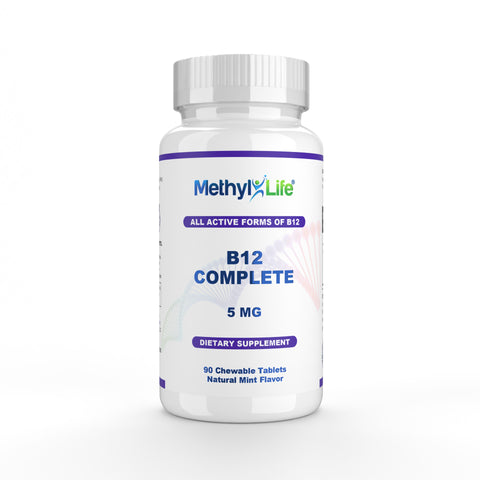
What is Vitamin B12?
Product Recommendations
B12 Complete 5 mg
$32.00
- All 3 Bioactive Forms of B12 for Full-Spectrum Absorption
- Methylcobalamin B12, Hydroxy B12 & Adenosylcobalamin
- 3rd-Party Tested for Purity, Potency & Safety
- 90 Vegan, Non-GMO, Chewable Mint Tablets

Written By:
Katie Stone - Naturopath
Medical Reviewer:
Kari Asadorian - BSN, RN
Edited By:
Jamie Hope - Methyl-Life® FounderUpdated On:
June 03, 2025What is Vitamin B12?
Vitamin B12 is one of the eight B vitamins. It is vital for brain and nerve function, red blood cell production and DNA synthesis. It helps turn homocysteine (a harmful amino acid) into methionine, which your body uses to build proteins and produce neurotransmitters that support healthy mood. B12 is also one of the most important nutrients involved in producing myelin, the protective sheath that insulates nerve fibers and allows for rapid signal transmission.1
The 4 forms of B12 and how they’re different
Vitamin B12 exists in four forms: three naturally active and one synthetic.
The three active, naturally occurring forms include methylcobalamin (MeCbl), adenosylcobalamin (AdCbl), and hydroxocobalamin (OHCbl).
- Methylcobalamin acts as a catalyst for several methylation processes throughout the body, including the synthesis of myelin protein, which forms the myelin sheath.
It also promotes the differentiation of Schwann cells (cells that support nerve cells (axons) improving nerve conduction, and increasing secretion of brain-derived neurotropic factors (BDNFs), all of which contribute to axon regeneration. - Adenosylcobalamin is the other coenzyme form of B12. It acts as a cofactor for methylmalonyl-CoA mutase, a key enzyme in the mitochondrial citric acid cycle. It supports energy metabolism and the breakdown of certain amino acids and fatty acids, which may help reduce fatigue and support metabolic function.2
- Hydroxocobalamin is a precursor that the body can convert into both methylcobalamin and adenosylcobalamin as needed. It is often used as an injectable treatment for vitamin B12 deficiency because it is highly stable and retained in the bloodstream longer than other forms.
- Cyanocobalamin is the inactive, synthetic form of B12. It is made in a laboratory and often used in supplements and foods, as it is relatively cheap to produce. The name ‘cyanocobalamin’ refers to the cyanide group within the molecule.3 The body must first convert cyanocobalamin into hydroxocobalamin to make it ‘active’ and usable. Some genetic variant statuses get in the way of this conversion process.
Foods that naturally contain B12
- Fish and seafood: Shellfish (clams, mussels, oysters) and fish (salmon, trout, canned sardines and tuna)
- Meat and poultry: Organ meats (liver, kidney). Lean meats (beef, lamb, pork, and chicken)
- Dairy products (lower B12 content): Milk, yogurt.
- Eggs
- Fortified B12 foods (contain synthetic cyanocobalamin)
Plant-based milks (soy, rice, almond, etc.)
Fortified cereals and breads
Snacks and beverages
Benefits of B12
Healthy red blood cell formation
B12 works with folate in maintaining healthy formation of red blood cells, which are key to delivering oxygen and nutrients around the body. Adequate B12 levels are also critical in preventing megaloblastic anemia.4
Energy production
B12 and other B vitamins function alongside enzymes that convert carbohydrates and fats into usable energy, supporting the mitochondria of the body’s cells.
Vitamin B12 and pernicious anemia
Elevated levels of homocysteine in the blood have been associated with an increased risk of cardiovascular disease and stroke. B12 works alongside folate and vitamin B6 to convert homocysteine to methionine.5
Maintaining healthy cognitive function
B12 maintains the myelin sheath surrounding nerve fibers, which assists with efficient signal transmission. Low B12 levels are associated with neuropathy, reduced memory function and cognitive decline.6
Supporting healthy mood
Folate and B12 work together to produce S-adenosylmethionine (SAMe), a compound required for the production of monoamine neurotransmitters and catecholamines, including serotonin and dopamine.7
Vitamin B12’s function in cognition and nervous system
Vitamin B12 is closely related to melatonin synthesis, the hormone responsible for regulating circadian rhythms and sleep–wake cycles. Research suggests that low B12 levels are associated with longer sleep onset latency and NREM sleep as well as with reduced REM sleep, reflecting poor sleep quality.8
MTHFR and B12 supplementation
Studies have shown that people with MTHFR genetic mutations are more likely to have lower levels of B12 and/or folate.9 The MTHFR mutation impairs the body’s ability to properly convert folic acid into active folate (methylfolate), which increases the risk of folate deficiency.
While MTHFR mutations are not a direct cause of B12 deficiency, both nutrients are required for the same methylation cycle. Low B12 may exacerbate the effects of reduced MTHFR enzyme function.10
Homocysteine levels are often elevated in people with MTHFR variants, especially the homozygous MTHFR C677T. The risk of elevated homocysteine is even higher in those with low B12.11 Supplementation with methylated forms of folate and B12 is often recommended to support methylation and help reduce homocysteine levels. 12
What is Vitamin B12?
Key takeaways
-
 Vitamin B12 is essential for supporting cognitive function, mood, red blood cell production, energy levels and reducing homocysteine.
Vitamin B12 is essential for supporting cognitive function, mood, red blood cell production, energy levels and reducing homocysteine.
-
 Methylcobalamin, adenosylcobalamin, hydroxocobalamin are the active, bioidentical forms of B12, while cyanocobalamin is the synthetic form.
Methylcobalamin, adenosylcobalamin, hydroxocobalamin are the active, bioidentical forms of B12, while cyanocobalamin is the synthetic form.
-
 People with MTR, MTRR, MTHFR mutations or who are vegetarian may need to supplement with B12.
People with MTR, MTRR, MTHFR mutations or who are vegetarian may need to supplement with B12.
Product Recommendations
Vitamin B12 5000 mcg (Methylcobalamin B12 Complete) – 3 Bioactive Forms
$32.00
- All 3 Bioactive Forms of B12 for Full-Spectrum Absorption
- Methylcobalamin B12, Hydroxy B12 & Adenosylcobalamin
- 3rd-Party Tested for Purity, Potency & Safety
- 90 Vegan, Non-GMO, Chewable Mint Tablets
Frequently Asked Questions about Vitamin B12
Vitamin B12 is essential for red blood cell formation, brain and nerve function, homocysteine metabolism and DNA synthesis. It helps maintain the myelin sheath around nerve cells responsible for neural communication, and is also required for the production of neurotransmitters that support healthy mood, normal sleep patterns, memory and other cognitive functions.
Natural B12 is only present in animal products. Rich sources include clams, mussels, liver, salmon, trout, beef and chicken. Dairy and eggs contain smaller amounts. Fortified foods such as cereals, breads, and processed snacks also contain B12, but this is the synthetic form, cyanocobalamin, that many do not convert well.
Anti-reflux medications such as proton pump inhibitors and H2-receptor antagonists reduce stomach acid, which can affect the body’s ability to release B12 from food. Metformin can also affect uptake of B12. If you are taking any medications, consult your health professional before supplementing with B12.
Yes, B12 may play a role in supporting healthy sleep patterns. Some research has suggested that B12 is linked to synthesis of melatonin, the hormone involved in sleep-wake cycles. Research suggests that low B12 levels are associated with difficulty falling asleep and as well as reduced REM sleep, which are both indications of poor sleep quality.13 However, B12 supplementation should not be considered a sleep aid, as other factors are often involved.
References
-
Carlos Alberto Calderón‐Ospina, Mauricio Orlando Nava‐Mesa; "B Vitamins in the nervous system: Current knowledge of the biochemical modes of action and synergies of thiamine, pyridoxine, and cobalamin"; CNS neuroscience & therapeutics; 2019 Sep
https://pmc.ncbi.nlm.nih.gov/articles/PMC6930825/
-
Lindsay H Allen, Joshua W Miller, Lisette de Groot, Irwin H Rosenberg, A David Smith, Helga Refsum, Daniel J Raiten; "Biomarkers of Nutrition for Development (BOND): Vitamin B-12 Review"; The Journal of nutrition; 2018 Nov
https://pmc.ncbi.nlm.nih.gov/articles/PMC6297555
-
Advait Vasavada, Preeti Patel, Devang K. Sanghavi; "Cyanocobalamin"; StatPearls [Internet]; 2024 Jan
https://www.ncbi.nlm.nih.gov/books/NBK555964/
-
Anis Hariz, Priyanka T. Bhattacharya; "Megaloblastic Anemia"; StatPearls [Internet]; 2023 Apr
https://www.ncbi.nlm.nih.gov/books/NBK537254/
-
Aditi Mohan, Ravi Kumar, Vivek Kumar, Mahendra Yadav; "Homocysteine, Vitamin B12 and Folate Level: Possible Risk Factors in the Progression of Chronic Heart and Kidney Disorders"; Current cardiology reviews; 2023 Jul
https://pmc.ncbi.nlm.nih.gov/articles/PMC10494275/
-
Shazia Jatoi, Abdul Hafeez, Syeda Urooj Riaz, Aijaz Ali, Muhammad Ishaq Ghauri, Maham Zehra; "Low Vitamin B12 Levels: An Underestimated Cause Of Minimal Cognitive Impairment And Dementia"; Cureus; 2020 Feb
https://pmc.ncbi.nlm.nih.gov/articles/PMC7077099
-
Makoto Naoi, Yuqiu Wu, Wakako Maruyama, Masayo Shamoto-Nagai; "Phytochemicals Modulate Biosynthesis and Function of Serotonin, Dopamine, and Norepinephrine for Treatment of Monoamine Neurotransmission-Related Psychiatric Diseases"; International Journal of Molecular Sciences; 2025
https://www.mdpi.com/1422-0067/26/7/2916
-
Izolde Bouloukaki, Antonios Christodoulakis, Theofilos Vouis, Violeta Moniaki, Eleni Mavroudi, Eleftherios Kallergis, Ioanna Tsiligianni, Sophia E. Schiza; "Association of Vitamin B12 Status with Polysomnographic Parameters and Cardiovascular Disease in Patients with Obstructive Sleep Apnoea"; Nutrients; 2025
https://www.mdpi.com/2072-6643/17/19/3079
-
Khalid M Al-Batayneh, Mazhar Salim Al Zoubi, Murad Shehab, Bahaa Al-Trad, Khaldon Bodoor, Wesam Al Khateeb, Alaa A A Aljabali, Mohammad Al Hamad, Greg Eaton; "Association between MTHFR 677C>T Polymorphism and Vitamin B12 Deficiency: A Case-control Study"; Journal of medical biochemistry; 2018 Apr
https://pmc.ncbi.nlm.nih.gov/articles/PMC6294092/
-
Sabrina Giammarco, Patrizia Chiusolo, Roberto Maggi, Monica Rossi, Gessica Minnella, Elisabetta Metafuni, Francesco D’Alò, Simona Sica; "MTHFR polymorphisms and vitamin B12 deficiency: correlation between mthfr polymorphisms and clinical and laboratory findings"; Annals of hematology; 2024 Aug
https://pmc.ncbi.nlm.nih.gov/articles/PMC11512882/
-
E. Zittan, M. Preis, I. Asmir, A. Cassel, N. Lindenfeld, S. Alroy, D. A. Halon, B. S. Lewis, A. Shiran, J. E. Schliamser, M. Y. Flugelman; "High frequency of vitamin B12 deficiency in asymptomatic individuals homozygous to MTHFR C677T mutation is associated with endothelial dysfunction and homocysteinemia"; American Journal of Physiology-Heart and Circulatory Physiology; 2007
https://journals.physiology.org/doi/full/10.1152/ajpheart.01189.2006
-
Andrew McCaddon, Joshua W Miller; "Homocysteine—a retrospective and prospective appraisal"; Frontiers in nutrition; 2023 Jun
https://pmc.ncbi.nlm.nih.gov/articles/PMC10294675
-
Izolde Bouloukaki, Antonios Christodoulakis, Theofilos Vouis, Violeta Moniaki, Eleni Mavroudi, Eleftherios Kallergis, Ioanna Tsiligianni, Sophia E Schiza; "Association of Vitamin B12 Status with Polysomnographic Parameters and Cardiovascular Disease in Patients with Obstructive Sleep Apnoea"; Nutrients; 2025 Sep
https://pmc.ncbi.nlm.nih.gov/articles/PMC12526031

About the Author
Katie is a qualified Naturopath (BNatMed) and freelance writer from New Zealand. She specializes in all things health and wellness, particularly dietary supplements and nutrition. Katie is also a dedicated runner and has completed more half-marathons than she can count!
Related Articles

What is the Best Form of B12 for You?
Written By: Jamie Hope - Methyl-Life® Founder

Like what you read?
Please subscribe to get more content like this sent to your inbox.
Share This Article
Trusted by Experts. Backed by Science.
Trusted professionals crafting original content backed by verified research. Since 2012, Methyl-Life® has been dedicated to providing evidence-based education to help individuals better understand methylation and nutritional wellness.
-

Expert-authored education
Every article and guide is written or reviewed by professionals specializing in methylation science and nutritional biochemistry.
-

Research-verified information
Our content references peer-reviewed studies and verified data, ensuring accuracy, integrity, and real-world relevance.
-

Educational leadership since 2012
A founder-led team collaborating with clinicians, researchers, and health writers to make complex science accessible and actionable.
-

Transparent and trustworthy
All educational materials undergo internal review for scientific accuracy, compliance, and clarity before publication.
Blog Categories
Table of Contents
Product Recommendations
Vitamin B12 5000 mcg (Methylcobalamin B12 Complete) – 3 Bioactive Forms
$32.00







